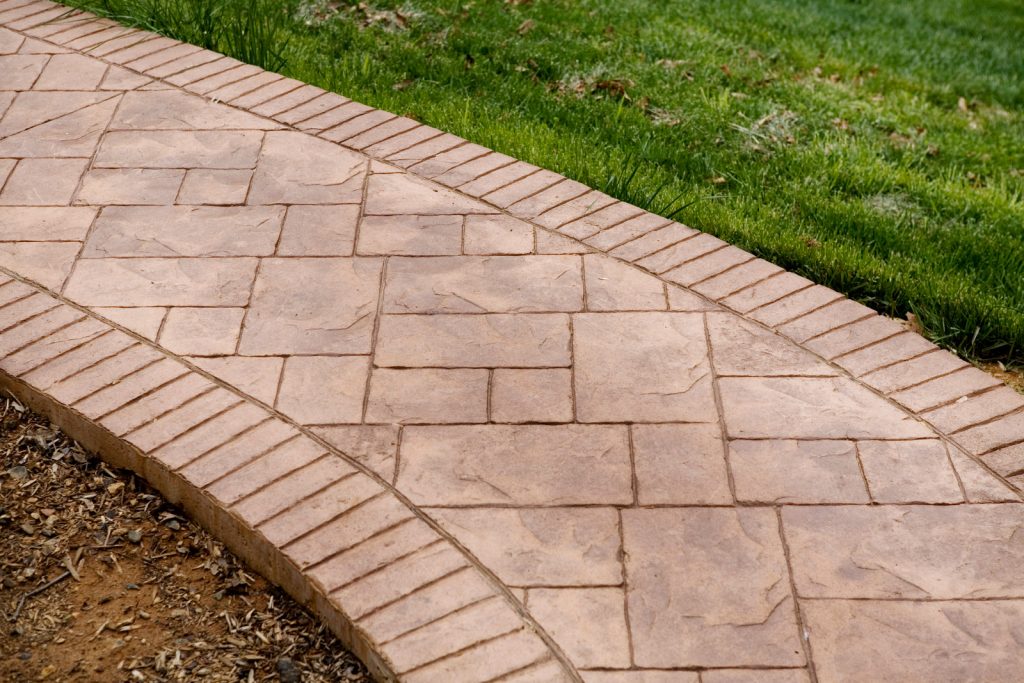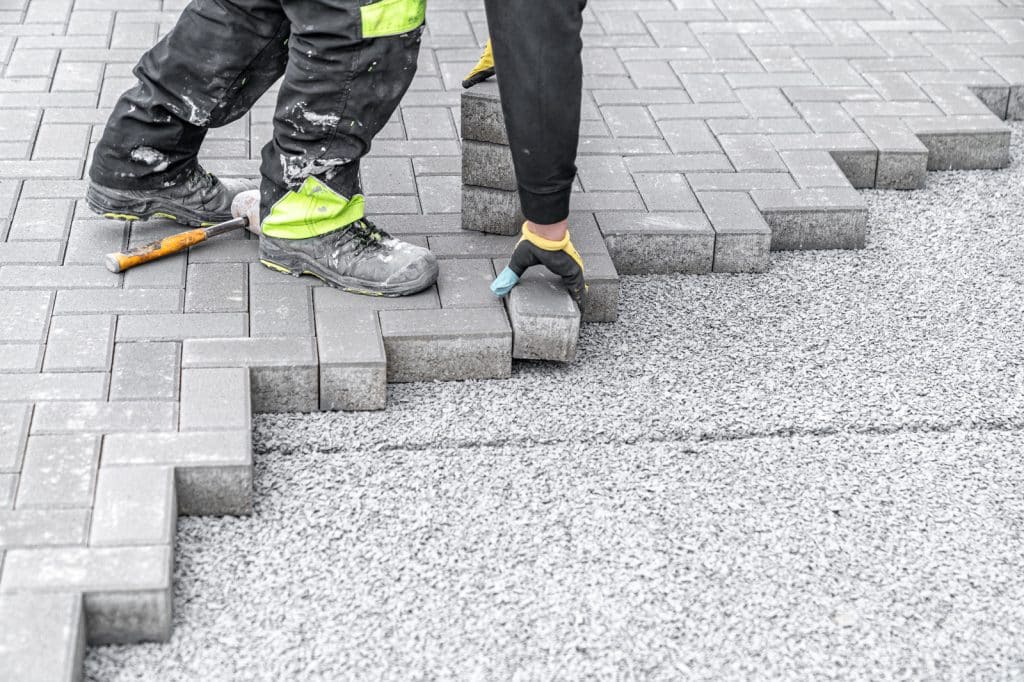When it comes to enhancing the outdoor aesthetics of your home, two popular choices are often considered: stamped concrete and pavers. Both options have their unique advantages and drawbacks, making the decision between the two dependent on various factors such as cost, maintenance, durability, and overall appearance. In this blog post, we’ll dive deeper into the details of stamped concrete and pavers to help you make an informed decision for your next landscaping project.
What is Stamped Concrete?

Stamped concrete is a type of concrete that is patterned, textured, or embossed to resemble brick, slate, flagstone, stone, tile, wood, and various other patterns and textures. It is commonly used for patios, sidewalks, driveways, pool decks, and interior flooring. The process involves pouring concrete into forms and then impressing a pattern onto the surface before it fully sets.
What are Pavers?

Pavers, also known as paving stones, are individual tiles made from various materials such as concrete, brick, or natural stone. They are used to create surfaces for walkways, patios, driveways, and other outdoor spaces. Pavers are laid out in a pattern and interlocked, which provides flexibility and ease of repair.
Cost Comparison
Stamped Concrete:
The initial cost of stamped concrete is generally lower than pavers. The cost per square foot typically ranges from $8 to $12, depending on the complexity of the design, the type of materials used, and the size of the project. However, it’s essential to consider that stamped concrete may require more maintenance over time, which can add to the overall cost.
Pavers:
Pavers tend to have a higher upfront cost, usually ranging from $10 to $20 per square foot, depending on the material and design. Despite the higher initial investment, pavers can be more cost-effective in the long run due to their durability and low maintenance requirements.
Installation Process
Stamped Concrete:
The installation of stamped concrete involves several steps:
- Site Preparation: The area must be excavated, and a stable base is prepared.
- Forming and Pouring: Forms are set up to contain the concrete, which is then poured and spread evenly.
- Stamping: While the concrete is still wet, stamps are pressed into the surface to create the desired pattern and texture.
- Curing and Sealing: The concrete must cure for several days before a sealant is applied to protect it from stains and weathering.
Pavers:
The installation of pavers includes:
- Excavation and Base Preparation: Similar to stamped concrete, the area is excavated, and a stable base is created using gravel and sand.
- Laying Pavers: Pavers are laid in the desired pattern and interlocked together.
- Edging and Sanding: Edging is installed to hold the pavers in place, and sand is spread over the surface to fill the joints and lock the pavers together.
Durability and Maintenance
Stamped Concrete:
- Durability: Stamped concrete is highly durable and can withstand heavy traffic and harsh weather conditions. However, it is prone to cracking over time, especially in areas with significant temperature fluctuations.
- Maintenance: Regular maintenance is required to keep stamped concrete looking its best. This includes resealing every two to three years to protect against stains, fading, and water damage. Additionally, any cracks that develop should be repaired promptly to prevent further deterioration.
Pavers:
- Durability: Pavers are incredibly durable and can last for decades with proper care. They are resistant to cracking because they are individual units that can move slightly with the ground, preventing large-scale damage.
- Maintenance: Pavers require minimal maintenance. Occasional cleaning and re-sanding of the joints are typically all that is needed. If a paver becomes damaged or stained, it can be easily replaced without disturbing the surrounding area.
Aesthetic Appeal
Stamped Concrete:
Stamped concrete offers a wide variety of design options. It can be colored and textured to mimic the appearance of natural stone, brick, or wood, providing a high-end look at a lower cost. The seamless surface can create a clean and cohesive appearance for patios and driveways.
Pavers:
Pavers offer versatility in design as well. They come in various shapes, sizes, and colors, allowing for intricate patterns and unique layouts. The natural variation in pavers can add character and charm to any outdoor space.
Pros and Cons Summary
Stamped Concrete:
- Pros:
- Lower initial cost
- Wide range of design options
- Seamless, cohesive look
- Cons:
- Prone to cracking
- Requires regular maintenance
- Difficult to repair
Pavers:
- Pros:
- Highly durable and long-lasting
- Easy to repair and replace
- Minimal maintenance required
- Cons:
- Higher initial cost
- Can be susceptible to weed growth in joints
- Installation can be time-consuming
Which is the Best Choice for You?
The decision between stamped concrete and pavers ultimately depends on your specific needs, preferences, and budget. If you are looking for a cost-effective solution with a wide range of design options, stamped concrete may be the better choice. However, if durability and ease of maintenance are your top priorities, pavers might be worth the higher initial investment.
Consider the following factors when making your decision:
- Climate: In areas with significant temperature fluctuations, pavers may be a better choice due to their resistance to cracking.
- Usage: For high-traffic areas, the durability of pavers can be advantageous.
- Aesthetics: Both options offer attractive designs, but the seamless look of stamped concrete may appeal to some, while the variety of paver patterns may appeal to others.
- Maintenance: If you prefer a low-maintenance option, pavers are typically easier to care for.
Conclusion
Both stamped concrete and pavers have their unique benefits and drawbacks. By carefully considering the factors outlined in this blog, you can choose the option that best suits your needs and enhances the beauty and functionality of your outdoor space. Whether you opt for the customizable elegance of stamped concrete or the enduring resilience of pavers, you can create a stunning and inviting environment for your home.
